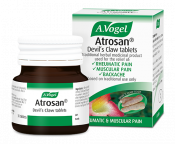Why exercise could bring you pain relief
Pain can cause a whole host of problems, including disruptions to sleep, limited mobility, anxiety and difficulty carrying out day-to-day tasks. The most obvious solution to this is to try painkillers; but, as this can come with side effects and maybe isn't something we want to rely on all the time, many people seek an alternative.
Today I am looking at how exercise may help pain. To do this I will cover the following topics:
- What does the research say about exercise and pain?
- Exercises to help back pain
- Exercises to help joint pain
- Exercises to help muscle pain
- Tips for exercising with aches and pains.
What does the research say about exercise and pain?
Exercise can improve the severity of pain, as well as the function of the muscles and joints.1 Let's take a look at some of the reasons for this.
Exercises releases endorphins
Any kind of physical activity is known to release chemicals known as endorphins. These are often described as being mood-boosting chemicals; however, they also act as natural pain killers. They react with opiate receptors in the brain, thus triggering a positive feeling that subdues our perception of pain.
Interestingly, research shows that we are more likely to feel the pain-relieving effects of endorphins if we partake in group exercises, rather than solo activities.2
A 2010 study observed these effects in a group of 12 rowers from the University of Oxford Boat Club Squad. Researchers thought the effects were likely down to the shared goals amongst the athletes, as well as the close co-ordination required for rowing.
Exercise may help with inflammation
Research has shown that just 20 minutes of exercise could help to reduce inflammation. This is because it reduces the number of immune cells producing TNF-α, a pro-inflammatory protein.3 This could have a positive impact on nerve pain4, as well as other inflammatory conditions.
Sufferers of conditions like arthritis may be put off exercising because of their pain and limited mobility. However, this study is really good news for this group as it shows exercise doesn't need to be really intense or long for benefits to be seen.
Exercise helps maintain a healthy weight
Regular exercise, in combination with a healthy diet, helps to support weight management. This ensures the joints do not have to bear extra weight which, in turn, may reduce the likelihood of joint pain and stiffness.5
Exercises to help back pain
Although back pain can be caused by a variety of factors, it is generally agreed that staying still is likely to slow healing and worsen the pain. In fact, research actually shows that exercise can reduce sick leave from back pain.6 So, what kind could you try out?
I recommend a routine of gentle stretching throughout the day. A yoga or Pilates workout targeted specifically towards back pain may also be a help.
If you are suffering from severe pain, though, it would be sensible to consult a physiotherapist to see what kind of movements would be most suitable for you.
Exercises to help joint pain
As with back pain, you might be cautious about doing exercise when suffering from joint pain for fear it'll make the problem worse. However, in actual fact, doing nothing is likely to pose more of a problem. Exercise increases joint strength and flexibility which can, in turn, reduce pain. Patients suffering from osteoarthritis, in particular, are known to benefit from regular movement.
A study of nearly 200 people with knee people found that those doing regular movement saw significant improvements to their physical function and pain levels when compared to a control group.7 The exciting thing about this particular research is that the effects were seen when participants did home workouts! So, check out some of our exercise videos to get started now.
Another activity that may be helpful is swimming, as this takes the weight off the joints and so avoids putting them under too much strain. Another option could be to try a flexibility workout. This may improve the range of motion in the joint and ease stiffness. It's also been shown to be beneficial for pain.8
Exercises to help muscle pain
For muscle pain, gentle stretching may again be beneficial, as it helps to loosen up the area. Walking and cycling are also unlikely to put too much strain on the body, so are good options.
You may, however, want to avoid any kind of weight-lifting session (or even just carrying loads of heavy shopping bags) until the pain has subsided.
Tips for exercising with aches and pains
Now that we have a list of activities to try out, here are my top tips for exercising with aches and pains:
- Avoid strenuous, high impact activities like running or HIIT workouts.
- Stop straight away if you find the pain is getting worse, and consult your doctor.
- Seek advice from a physiotherapist for exercises tailored to your condition.
- Progress slowly – don't try to do too much, too quickly, is always my advice!
- Use the facilities available to you. If you can't get out to an exercise class, for example, have a look online for an exercise video. Check out our page on exercises to do at home for more information.
- Remember, any type of movement is preferable to a sedentary lifestyle. Whether you choose to walk up the stairs in your house a couple of extra times a day, or you join a walking club to get out and about more regularly, do what suits you and spend less time sitting in the process.
- Rest between harder workouts. Allow your muscles a couple of days recovery time and you'll come back stronger the next time around.
- Try a hot bath after your workout to soothe any Delayed Onset Muscle Soreness. This is discomfort in the muscles that occurs when we haven't done a particular exercise in a while. It will take a couple of days to ease off but is nothing to worry about.
- Warm-up and cool down before a workout to prevent the likelihood of injury.
- If your pain is caused by an injury, such as a sprain or strain, give the area time to heal and avoid any strenuous movement in that area.
References
1 https://www.ncbi.nlm.nih.gov/pmc/articles/PMC5461882/
2 https://www.ncbi.nlm.nih.gov/pmc/articles/PMC2817271/
3 https://www.sciencedirect.com/science/article/abs/pii/S0889159116305645
4 http://dx.doi.org/10.1213/ANE.0b013e31824c4ed4
5 https://www.ncbi.nlm.nih.gov/pmc/articles/PMC4534717/
6 https://research.vu.nl/ws/portalfiles/portal/2571082/233675.pdf
7 https://www.ncbi.nlm.nih.gov/pmc/articles/PMC1752761/pdf/v058p00015.pdf
8 https://pubmed.ncbi.nlm.nih.gov/24651512/





 Looking for a treatment to relieve pain in conditions such as muscle aches or pains, stiffness, rheumatic pain or after sporting injuries?
Looking for a treatment to relieve pain in conditions such as muscle aches or pains, stiffness, rheumatic pain or after sporting injuries?

